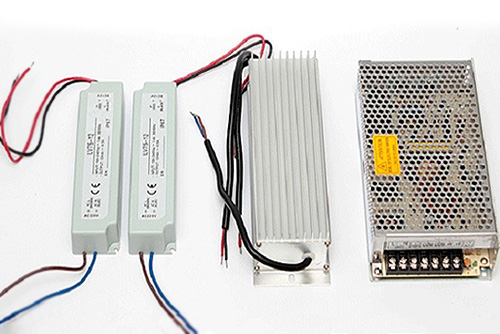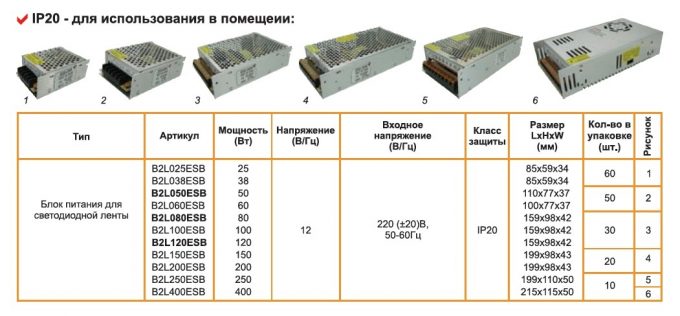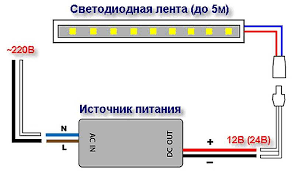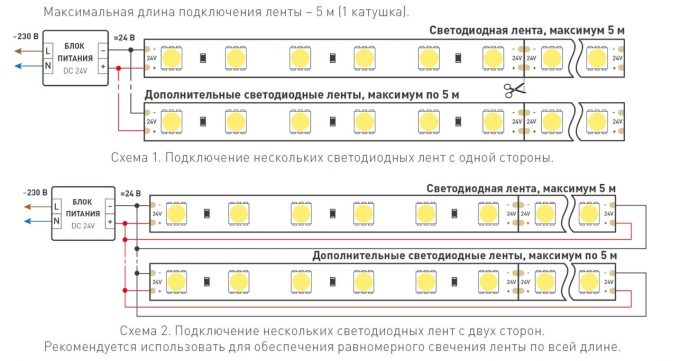Selecting a power supply for connecting an LED strip is an important step in the lighting installation process.. Here are the basic principles, which should be taken into account when choosing a power supply are
power and voltage. Determine the total power of the LED strip. Multiply the length of the tape by the power of one meter of tape, specified by the manufacturer. Note, that the power supply must have power reserve 20-30%. Make, that the selected power supply has the required voltage. Typically LED strips operate on 12V or 24V.
Connection type: Power supplies can have one or more outputs. If you need to connect several pieces of LED strip, make, that the power supply has enough outputs.
Overheat and short circuit protection, choose a power supply that is protected from these problems. This will help extend the life of the block and LED strip..
Choose a compact power supply, which easily fits in an installation box or behind the ceiling. Determine the installation location of the power supply and take into account, that it should be easily accessible for maintenance.
Selecting a power supply
The power and voltage of the power supply for the LED strip depends on the type and length of the strip itself.
12-Voltage LED strips are usually used in everyday life using power supplies 60 W or less. To calculate the power you need to know the length of the tape and the power consumption of one meter.
24-volt led strips, usually, used for commercial purposes and require more powerful power supplies. It is also important here to calculate the total length of the tape, to select a suitable power supply.
Anyway, It is important to choose a power supply with power reserve, to avoid overheating and premature failure.
Review the terms and conditions, in which LED strip will be used, to determine the optimal voltage.
Generally, power supply 12v or power supply 24 volt, depends on your specific needs and project requirements. Both options have their advantages, and the right choice depends on the unique characteristics of your project.

Connection settings
To select a power supply for LED strip, you will need to consider several key parameters. Here are the steps, which will help you choose the right power supply:
- Voltage (Voltage): Make, that the power supply voltage matches the required voltage of your LED strip. LED strips often operate at 12V or 24V.
- Power (Power): Calculate the total power of the LED strip. It can be done, multiplying the power of one meter of LED strip by the total length. Choose a power supply with power, exceeding this total power.
- current (Current): current, consumed by LED strip, also important. It is usually indicated on the packaging of the LED strip. Make, that the power supply provides the required current.
- Connection type (Connection type): accurate, how the LED strip is connected to the power supply. Some LED strips have connectors, while others may require soldering.
- Overload protection (Overload protection) and short circuit (Short-circuit protection): Make sure, that the power supply provides overload and short circuit protection, to prevent damage to the LED strip.
- Quality and reliability: Choose a power supply from reliable manufacturers, to avoid power problems, which may affect the operation of the LED strip.
- Power reserve (Power margin): It is recommended to choose a power supply with some power reserve, to ensure system stability. Power supply power reserve. He should be around 20-30% more, than the total power of your tape.
- Certification: Make sure, that the power supply complies with the necessary standards and safety regulations.
- Working temperature: Make, that the power supply is capable of operating in those temperature conditions, in which LED strip is supposed to be used.
It should be noted, that in case of doubt or if you have specific features of the LED strip, It is recommended to consult with the LED strip manufacturer or contact an electrical specialist.
Basics of choosing LED strip
The choice between a 12V or 24V LED strip depends on the specific requirements and conditions of use..

Let's look at the main aspects of the 12V LED strip.

Benefits:
- More common option.
- Wide selection of products and accessories on the market.
- Usually more affordable price.
disadvantages:
- Length limitation: Over long runs, the tape may lose brightness and experience tension problems at the ends.
- Increased energy loss over long distances.
LED strip 24V:
Benefits:
- Less voltage loss: Allows longer stretches of tape to be used without reducing brightness.
- More efficient energy transfer over long distances.

disadvantages:
- May be more expensive to purchase.
- There may be less choice on the market compared to 12V strips.
If you need to illuminate large areas or long areas, LED strip 24V is preferable. It is important to choose the right Power Supply 24 volt.
If brightness stability over long distances is important, 24V tape can provide an advantage.
24V LED strips are often more effective in transmitting energy over long distances.












